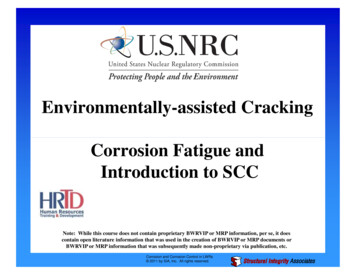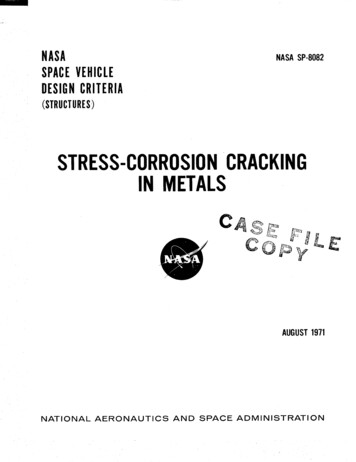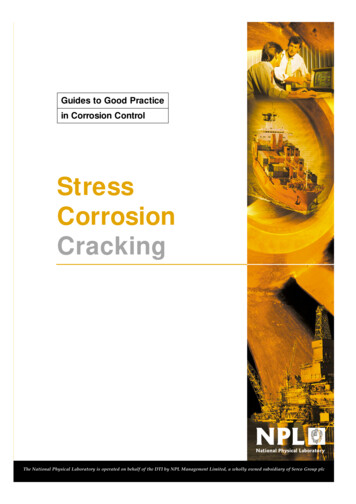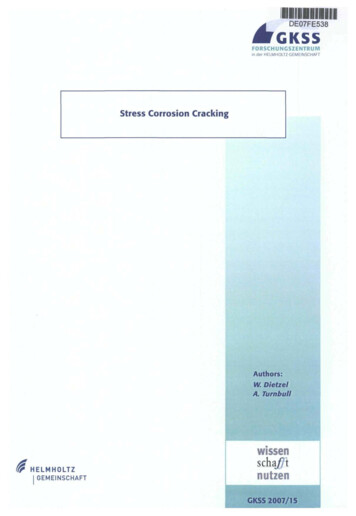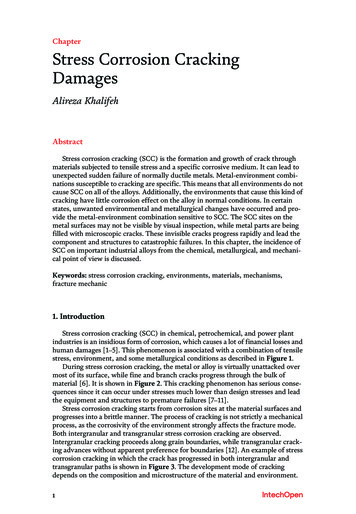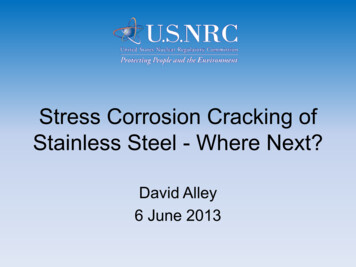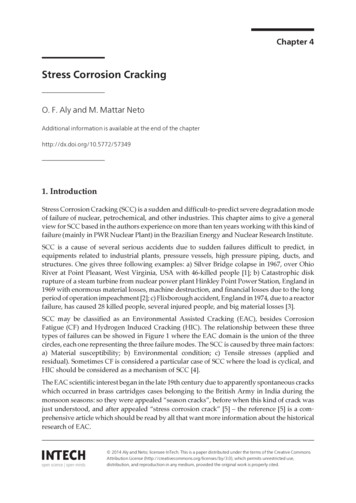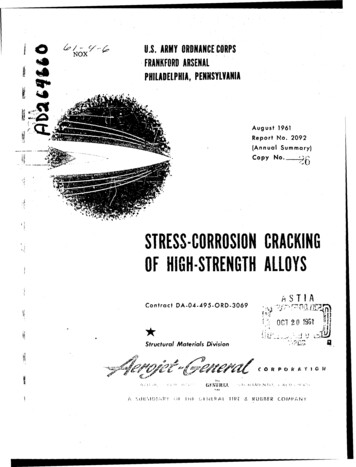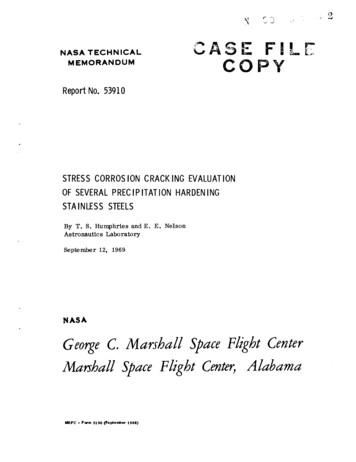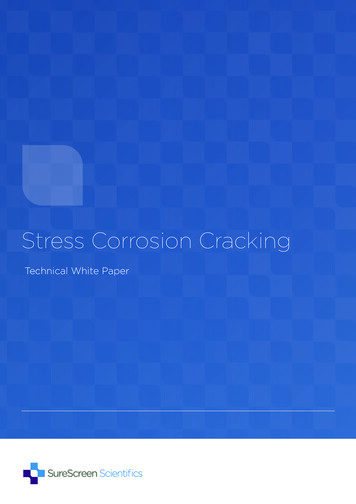
Transcription
Stress Corrosion CrackingTechnical White Paper
SURESCREEN SCIENTIFICSDescriptionStress corrosion cracking (SCC), or ‘environmental-sensitive cracking’, is the formation and growth of a crack througha material which is subject to a particular set of conditions. These conditions include the presence of a tensile stress, acorroding medium and a susceptible material. Many alloys are prone to SCC, but the necessary conditions don’t occurthat often. This can be dangerous when they do; failure could be unexpected.SCC in austenitic stainless steel.One of the earliest cited cases of SCC was a phenomenon termed ‘season cracking’ applied to the brass cartridgecases used by the occupying British forces whilst in India during the nineteenth century. During the monsoon season,the ammunition was stored in horse stables until the dry weather returned. It was apparent that during storage, thecartridges would often crack, and particularly where the case was crimped to the bullet. In 1921 the phenomenon wasexplained by Moor, Beckinsale and Mallinson, as a combination of the ammonia inherent in the horse urine, and theresidual stress that remained in the cold-drawn metal of the cartridges that caused the cracking.02 SURESCREEN SCIENTIFICS
SURESCREEN SCIENTIFICSMechanismVirtually all metals and alloys are susceptible to SCC under certain conditions that include stress, environment, electrodepotential, temperature, contamination, physical damage, or changes in microstructure. Stress may be applied (pressure,thermal, centrifugal, load etc.) or residual (welding, heat treatment, cold work etc). It can be affected by local stressconcentrations too (pitting, geometry, microstructure, corrosion product wedging) and by corrosion concentration(evaporation, differential aeration, build up under coatings and in cracks etc). However, most components operateoutside the SCC ‘envelope’ either by good fortune or because of some limited understanding of the problem; somematerials have a wider ‘envelope’ than others.One reason SCC can be unpredictable is that it requires a crack initiation stage, but at the start, the growth rate canbe slow which means the embryo crack may go unnoticed due to its size; it will be small, tightly closed, and could befilled with corrosion product. It is not unknown for components to resist many thousands of hours of exposure to thecorrosive environment with apparently little attack until the embryo cracks develop. Then, growth can be rapid.SCC occurs when metals are exposed to ‘fluids’ (aqueous, steam, vapour and molten salts). Usually, but not always,temperatures above 50 C are involved too. The all-important initiation stage requires time-dependent changes ineither the attacking solution or the metal, through chemical or electrochemical action to locally concentrate the attackat the atomic level. Sometimes, local concentration increases through physical means such as evaporation or localisedconductivity changes through the setting up of an electrical cell where different metals or different oxygen levels exist.This cell can also be set up by any discontinuity in the metal surface. It is this variability in initiation conditions thatmakes SCC rather difficult to predict.A further factor in SCC is the role of hydrogen, and the effects of hydrogen embrittlement (HE). Many papers on SCCand HE consider these two phenomena as synonymous. Corrosion mechanisms in aqueous environments will generatehydrogen in its atomic form. Depending on the local environment, this hydrogen may be adsorbed into the metalstructure and contribute to cracking. HE will not be discussed further in this paper and is covered in more depth in thewhite paper on HE found elsewhere on the SureScreen website.Machining marks and scores (especially poor machining surfaces), generate residual stresses at the surface as wellas providing pits and crevices for cells to develop. Lapped and smeared metal seems particularly susceptible to SCC;therefore, machining should be done with appropriate sharp tools and adequate feed rates and cutting speeds. Whenkeyways are cut by milling, avoid smearing or lapping the metal on the sides or corners. Such damage at a machinedkeyway was thought to be the contributing factor in the failure of a turbine disc at Hinckley Nuclear Power Stationin 1969. Controlled experiments have shown that rough surfaces fail by SCC faster than smoother surfaces. This isprobably because machining that disturbs the metal more deeply will leave behind higher residual stresses, as it isnot uncommon for machining to influence metal several millimetres below the surface, in addition to providing stressconcentration points. Often, SCC could be avoided by improved surface finish, and reduced stress concentrations byimproved geometry.Non-metallic inclusions are another source of SCC target. Some types of inclusions are more harmful than othersdepending on the alloy, due to three significant effects. Firstly, in stagnant conditions the inclusion will affect the local chemistry, Secondly, dissolution of inclusions will leave a pitted surface, Thirdly, sulphides, when attacked chemically will generate hydrogen sulphide locally that removes passiveoxide films and forms hydrogen in the surrounding metal leading to HE/Sulphide SCC.All wrought metals have a ‘grain direction’ that originated from the rolling of the bulk billet or continuous cast strand.The orientation of the rolling direction can be important, because it has been found that SCC occurs more frequentlyon a cross-section, parallel to the rolling direction, than perpendicular to the rolling direction. Since most steels containsome degree of manganese sulphide inclusions that have been elongated into rod shapes by steel manufacture,inclusions exposed on a cross section penetrate much deeper than those exposed in their aligned direction.03 SURESCREEN SCIENTIFICS
SURESCREEN SCIENTIFICSIt is thought that manganese sulphide rods that penetrate into the metal provide a much greater reservoir of hydrogensulphide and hydrogen. Therefore, if there is an option, expose only the plate or bar surface and not the cross section.Also, sulphides that break the surface are more prone to SCC in stagnant conditions due to bacterial attack (MicrobialInduced Corrosion).It has been noted that oxides form preferentially at these sites when temperatures are high enough for oxidationto occur. Iron oxide has a volume that is about twice that of the metal it formed from. As a finger of oxide growspreferentially down the rod-like inclusion, it can result in a process called oxide wedging in which the expanded oxidevolume stresses the surrounding metal, leaving it more prone to SCC.Oxide is also very brittle, so a change in stress can fracture this oxide wedge, resulting in a crevice that exacerbatesthe situation. This is another reason to avoid end-grain exposure, but it also suggests that low sulphur steels are betterthan high sulphur steels.It is not widely appreciated that SCC occurs more readily in metals that are subjected to a very low frequency stresscycle, such as might occur from on/off cycles in a heating system. Furthermore, the severity of SCC will be dependanton the balance between the level of stress and the corrosivity of the environment; a high stress may only need a lowlevel of corrosivity, and correspondingly, a high level of corrosivity would only need a low level of stress for SCC todevelop.SCC may propagate through a metal by intergranular, transgranular, or a combination of both modes.Intergranular AttackIntergranular fracture can be identified by smooth facets on the grain boundary surface when examined by electronmicroscopy. Often, a layer of corrosion product can be seen on the fracture surface, as shown in the image below of afractured bolt, or the exposed surface may even be darkened and indistinct.2mmFracture surface of a high strength steel bolt showing discolouration consistent with light corrosion attack, typical of SCC.04 SURESCREEN SCIENTIFICS
SURESCREEN SCIENTIFICSIntergranular cracking is common in: carbon steels exposed to caustic, nitrate, acetate and carbonates; low alloy steelswith water and steam; sensitised stainless steel and oxygenated water; aluminium alloys and steam or water vapour;beta-titanium alloys exposed to methanol and water; tempered martensitic stainless steels exposed to chlorides (seeimage below).SEM image of an area on the bolt shown in the above image revealing intergranularcracking and secondary cracks extending into the surface.With intergranular attack, the grain boundary is often the preferred route for the crack to grow because in these alloysthe grain boundaries and the grains may themselves have slightly different compositions.An alloy is a mix of one or more metals, and as an alloy solidifies the growing crystals of solid metal in the melt attracta greater proportion of the main elements while the lesser elements are pushed aside into the liquid. As the liquid coolsand the crystals grow, they develop a shell of solidifying metal with an increasingly greater proportion of less puremetal, until the last portions to solidify have a much greater level of the alloying elements compared with the metalat the centre of the grains. These last portions to solidify are the grain boundaries. They have a different compositionto the grains and some SCC systems prefer them. Some alloys have a wide freezing range and develop this effect to agreater extent. Etching a cross section of these alloys shows the alloy distribution in a pattern known as ‘coring’.Other alloys have a narrow freezing range and develop less coring. One such alloy, aluminium containing around 12%silicon, has a much narrower freezing range, so it can be cast with thinner cross section without the risk of shrinkage.It probably follows that alloys with a narrow freezing range are less likely to be susceptible to intergranular SCCmechanisms. The Al-12%Si develops two distinct phases. Other alloys that produce distinct phases, like Al-Mg alloysthat can develop continuous precipitates of Mg5Al8 generate anodic cells with respect to the matrix. This inducesintergranular SCC in chloride solutions.05 SURESCREEN SCIENTIFICS
SURESCREEN SCIENTIFICSTransgranular AttackTransgranular cracks are commonly observed in failure investigations, especially in stainless steel exposed to acidicchlorides, in low strength ferritic steels exposed to acids, in alpha brass exposed to ammonia solutions (although insome conditions, intergranular cracking may develop), in aluminium alloys exposed to chlorides, and in magnesiumalloys exposed to dilute fluorides.Transgranular fractures appear to have cleavage-like facets, with fan-like river markings. There is usually a ‘tunnelling’effect from side branches that can only be seen on cross sections, though electron microscopy does reveal fissuresbetween grains that have characteristic tunnelling inconsistent with overloading. There is often a tendency to targetgrain boundaries close to inclusions, with dissolution of the local area through corrosion. Sometimes a coating ofcorrosion product can be analysed to identify the chemicals responsible.The theory of tunnelling comes from the mechanism of attack which is thought to develop primarily along planes ofatoms; metal grains consist of ordered arrays of atoms, one stacked on top of the other. Artefacts of these planes canbe seen as pairs of parallel lines in the microstructure of austenitic stainless steel and brass that have been annealed,when the assembly of stacked atoms generate a ‘stacking fault’ known as a twin boundary.Transgranular SCC develops from a boundary, stacking fault or locally slipped stack of packed atoms that breaks thesurface. The boundary interface is breached by the chemical ions, driven by the electrochemical cell that developsduring passivation of the surface. This local attack causes a pit and is accompanied by sliding of the packed atoms overeach other, producing a misfit known as a dislocation.The dislocation is penetrated by the corroding chemical, and the process is repeated. Although the effect usuallydevelops slowly, sometimes cracking propagates at an alarmingly fast rate of minutes or hours, especially worryingwhen the component may have been operating quite successfully for years previously. On such occasions the term‘electrochemical knife’ has been used to describe the cleaving open of planes of atoms in a transgranular path.AppearanceSCC may be observed in different forms, depending on the prevalent conditions and environment. On initial examinationaffected surfaces may exhibit fine linear cracks or just stain marks although SCC may often initiate at features thatrender them impossible to observe e.g. from crevices, thread roots, steps in the base of holes etc. Identification of SCCmay then be reliant on effective non-destructive testing or microexamination of sections through the component.The images below show through-thickness SCC that developed from an internal surface, and specifically areas ofcrevice corrosion.06 SURESCREEN SCIENTIFICS
SURESCREEN SCIENTIFICSOuter surface of a stainless steel component showing corrosion staining highlighting the cracks.2mmInternal surface of the component shown above showing straight SCC and patches of crevice corrosion.If components can be sectioned for metallurgical examination, SCC may often be readily observed as a network of finebranched cracks such as that shown below.07 SURESCREEN SCIENTIFICS
SURESCREEN SCIENTIFICSSCC of stainless steel. Image showing elongated pools (stringers) of delta ferrite (grey horizontal features)in an austenite matrix, with SCC cracks (running vertically) and corrosion attack around some of the ferrite stringers(x500 magnification).Laboratory analysis of SCC will often include examination by SEM and semiquantitative elemental analysis using thex-ray facility of the SEM (SEM-EDX), particularly when trying to identify what damaging species had contributed to theSCC. For example, SCC of stainless steels is often caused by the presence of chlorides, ions of the element chlorine.SEM-EDX analysis of cracks, and particularly of crack surfaces which have been exposed specifically for the analysis,minimising the potential for contamination, will be particularly interested in identifying the presence of chlorine.SCC failures of copper alloys, such as brasses, may exhibit varying levels of corrosion damage. This may be observedjust as a slight dulling of the brass colour, to significant darkening, dependant on the severity of the corrosion attack.The image below shows such severe darkening indicative of a relatively aggressive environment.Exposed fracture face of SCC in a brass component showing a highly brittle surface with corrosion staining. The crackhas originated from the top surface as indicated by the fractographic features and the increased corrosion products.08 SURESCREEN SCIENTIFICS
SURESCREEN SCIENTIFICSSection through the brass component shown in the image above showing the highly branched cracks (x500 Mag.)Avoiding SCCSince SCC is a function of stress, a susceptible material, and a corrosive environment, measures to avoid SCC mayfocus on one or more of these factors, for example; Avoidance of chemicals or substances that are known to cause and/or accelerate the SCC mechanism. Isolation of the surface of the material from the environment if the environment cannot be changed or controlled. The introduction of shot-peening to introduce compressive stresses in the surface to reduce the potential forcrack initiation. Reducing surface damage or irregularities from machining. Controlling the stress levels that a component experiences as well as the correct hardness being achievedcan also lower than chances of SCC. Heat treatment to eliminate or reduce residual stress may be beneficial. Modification of design to reduce nominal stress, or areas of stress concentration. The use and selection of materials resistant to corrosion in the given application. The control of electrochemical potential of the alloy in use to avoid corrosion processes such as may beexperienced with cathodic protection.ExamplesExample 1A 24mm diameter bolt had fractured in service. Examination revealed an unusual fracture that occurred in the head,rather than under the head or in the threads as is typically observed in bolt failures. The fracture followed a concaveform within the head, as seen in the image below:09 SURESCREEN SCIENTIFICS
SURESCREEN SCIENTIFICSSection through the bolt head showing the concave path of crack propagation.The unusual form of the fracture follows the general location of highest stress as may be identified in finite elementmodels.Example 2A tubular fabrication used in an automotive application failed some weeks after entering service. Investigation identifieda crevice at an area of weld lack-of-fusion. This crevice had harboured damaging chemicals from the cleaning andcoating processes which resulted in crevice corrosion, from which SCC had then propagated into the cross-section ofthe tube as shown in the image below. A fatigue crack had then subsequently propagated from the SCC leading to thecomplete fracture of the tube.Section through the fracture face of a low carbon steel showing branched SCC extending into the metal (x200 Mag.)10 SURESCREEN SCIENTIFICS
SURESCREEN SCIENTIFICSExamples of SCC Associated with Swimming PoolsSince 1985 there have been five incidents of SCC which have led to the catastrophic failure of suspended ceilings inswimming pools, resulting in a combined loss of 56 lives across Switzerland, the Netherlands and Russia, namely: Uster Indoor Swimming Pool (Zurich, Switzerland), 1985.Steenwijk Muncipal Pool (Steenwijk, the Netherlands), 2001.Transvaal Pool (Moscow, Russia), 2005.Dolphin Pool Complex (Chusovoy, Russia), 2005.Zwembad Reeshof Swimming Pool (Tilburg, Netherlands), 2011.In each of the cases listed above, catastrophic failure occurred leading to the collapse of the suspended ceilingconsequentially crushing the people below. Although, this was not the case at Steenwijk as the ceiling collapsed duringclosing hours of the pool.In the majority of cases the pools had either fasteners that were made of insufficiently coated carbon steels or weremade from austenitic stainless steels which were susceptible to stress corrosion cracking in environments high inchlorides, inherent in the swimming pool environment.In swimming pools, the chloride production is predominantly generated from disinfectant compounds which are addedto the swimming pool water to increase hygiene. Commercially used disinfectant is generally hypochlorous acid andsodium hypochlorite which is known to react in the presence of water with organic materials that are produced bythe human users of the pool e.g. sweat, skin particles and urine to form di-chlorine-amine as well as trichlorine-aminewhich then evaporates from the surface of the pool, concluding in the deposition as condensation on fasteners androof members, often at high concentrations.11 SURESCREEN SCIENTIFICS
scientifics@surescreen.com ( 44) 0 1332 292003 surescreenscientifics.com
Stress corrosion cracking (SCC), or 'environmental-sensitive cracking', is the formation and growth of a crack through a material which is subject to a particular set of conditions. These conditions include the presence of a tensile stress, a corroding medium and a susceptible material. Many alloys are prone to SCC, but the necessary .
